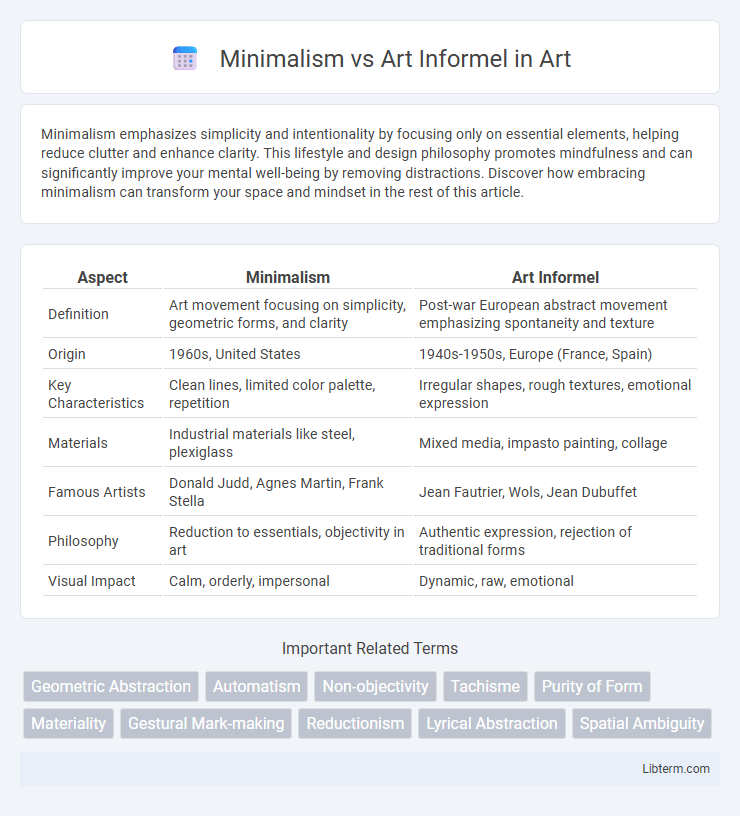Minimalism emphasizes simplicity and intentionality by focusing only on essential elements, helping reduce clutter and enhance clarity. This lifestyle and design philosophy promotes mindfulness and can significantly improve your mental well-being by removing distractions. Discover how embracing minimalism can transform your space and mindset in the rest of this article.
Table of Comparison
| Aspect | Minimalism | Art Informel |
|---|---|---|
| Definition | Art movement focusing on simplicity, geometric forms, and clarity | Post-war European abstract movement emphasizing spontaneity and texture |
| Origin | 1960s, United States | 1940s-1950s, Europe (France, Spain) |
| Key Characteristics | Clean lines, limited color palette, repetition | Irregular shapes, rough textures, emotional expression |
| Materials | Industrial materials like steel, plexiglass | Mixed media, impasto painting, collage |
| Famous Artists | Donald Judd, Agnes Martin, Frank Stella | Jean Fautrier, Wols, Jean Dubuffet |
| Philosophy | Reduction to essentials, objectivity in art | Authentic expression, rejection of traditional forms |
| Visual Impact | Calm, orderly, impersonal | Dynamic, raw, emotional |
Defining Minimalism: Core Principles
Minimalism centers on simplicity, emphasizing clean lines, geometric forms, and a limited color palette to highlight the essence of objects without extraneous detail. Core principles include repetition, uniformity, and the use of industrial materials, aiming to create a sense of order and clarity. This contrasts sharply with Art Informel's emphasis on spontaneous, gestural brushwork and emotional expression, favoring abstraction and texture over Minimalism's precision.
Understanding Art Informel: Origins and Concepts
Art Informel emerged in post-World War II Europe as a reaction against traditional artistic conventions, emphasizing spontaneity, abstraction, and the expression of raw emotion. Unlike Minimalism, which focuses on simplicity and geometric forms, Art Informel prioritizes texture, irregularity, and the subconscious, often employing gestural brushwork and unconventional materials. The movement's origins are rooted in existential philosophy, aiming to capture an authentic human experience through unstructured and intuitive artistic processes.
Historical Context: Postwar Art Movements
Postwar art movements saw Minimalism emerge in the 1960s as a reaction against the emotional intensity of Art Informel, which dominated Europe in the late 1940s and 1950s with its chaotic, abstract expressionist styles. Art Informel reflected the existential uncertainty and trauma of World War II, emphasizing spontaneous, unstructured creativity, while Minimalism pursued clarity, order, and simplicity through geometric forms and industrial materials. These movements illustrate divergent responses to the historical trauma and cultural shifts following World War II, with Minimalism advocating for rationality and Art Informel embodying emotional immediacy.
Key Artists: Minimalism vs Art Informel
Key artists in Minimalism include Donald Judd, Agnes Martin, and Frank Stella, known for their emphasis on simplicity, geometric forms, and industrial materials. In contrast, Art Informel features artists like Jean Dubuffet, Wols, and Pierre Soulages, who focus on spontaneous, expressive gestures and textured surfaces reflecting existential themes. These distinct artistic approaches highlight Minimalism's precision and order versus Art Informel's emphasis on emotional intensity and material experimentation.
Visual Language and Techniques
Minimalism employs a visual language characterized by geometric forms, repetition, and a restrained color palette, emphasizing simplicity and precision through techniques such as hard-edged painting and industrial materials. Art Informel contrasts this with spontaneous, gestural brushstrokes, textured surfaces, and an expressive use of color, prioritizing emotional intensity and organic forms. The techniques in Art Informel include impasto, irregular application, and non-traditional tools, creating a raw, dynamic visual language that challenges Minimalism's controlled aesthetics.
Philosophical Differences in Approach
Minimalism emphasizes simplicity, order, and clarity, advocating for a reduction to essential forms to evoke universal truths and objective experiences. Art Informel rejects structured composition, embracing spontaneity, emotional intensity, and the subconscious as a means to express existential uncertainty and individual subjectivity. These philosophical differences highlight Minimalism's pursuit of rationality and permanence versus Art Informel's embrace of chaos and impermanence.
Influence on Contemporary Art
Minimalism's emphasis on simplicity and geometric forms redefined contemporary art by encouraging artists to explore spatial relationships and viewer perception, leading to a focus on purity of form and materiality. Art Informel's gestural abstraction and emphasis on spontaneity introduced a raw emotional intensity and embraced imperfection, influencing contemporary artists to prioritize expression and texture over traditional structure. Together, these movements expanded the boundaries of artistic practice, shaping diverse approaches in painting, sculpture, and installation art within the contemporary scene.
Reception and Critique in the Art World
Minimalism's reception emphasized its clean lines and reduction to essential forms, celebrated for clarity and intellectual rigor, while it faced critique for perceived emotional coldness and lack of personal expression. Art Informel garnered acclaim for its spontaneous, expressive gestures and raw textures, resonating with post-war existential themes but was criticized for perceived chaos and lack of formal structure. The art world debated these movements in terms of emotional engagement versus formal purity, highlighting divergent approaches to abstraction and meaning in mid-20th-century art.
Minimalism and Art Informel in Architecture and Design
Minimalism in architecture emphasizes simplicity, clean lines, and functional spaces, using minimal materials to create a sense of order and tranquility. Art Informel, in contrast, embraces spontaneity, texture, and organic forms, often incorporating raw, unfinished surfaces to convey emotional intensity and unpredictability. The juxtaposition of Minimalism's geometric precision against Art Informel's expressive abstraction highlights diverse approaches to modern design and spatial experience.
Enduring Legacy and Modern Interpretations
Minimalism's enduring legacy lies in its emphasis on simplicity, geometric forms, and the rejection of emotional excess, influencing contemporary design, architecture, and digital aesthetics. Art Informel's legacy is rooted in its spontaneous, gestural expressions that challenge traditional structures, continuing to inspire abstract expressionism and contemporary mixed-media practices. Both movements shape modern interpretations by offering contrasting approaches: Minimalism's clarity and restraint versus Art Informel's dynamic, intuitive creation process.
Minimalism Infographic

 libterm.com
libterm.com